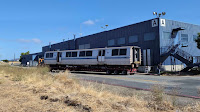It's rare for me to even mention anything with an internal combustion engine in relationship with PNAERC, but on occasion, something pops up that's cool enough that even I can't manage to find it uninteresting. And so, courtesy of some timely photos and information from our friend Bill Wall, I present the Evans Auto-Railer.
Back in the 1930s, there was a small market for rail buses, with many of the examples built going to traction lines to either replace or feed into electric railway operations (see the Grafton rail bus and the slightly later Houston-North Shore rail bus, both preserved at the National Museum of Transportation). Around 1935, a company called Evans started building modern, streamlined rail buses patterned after the city buses of the day. These weren't normal rail buses, though, because they had both rubber tires and railroad wheels - think Hy-Railer - and could operate both on and off the tracks. Evans called them Auto-Railers, and only one has survived to the present day.Pictured here, it has just been acquired by the National Capital Trolley Museum. That's a good home for it because it came from the Arlington & Fairfax in Virginia, an electric line that had just taken down its wires. It was built in 1936 and only ran on the A&F until 1939, which is when that line was abandoned. This example was sold to the Arcade & Attica in western New York, where it resided until it went to Clark's Trading Post in New Hampshire in the late 1950s. It has been there ever since. Other examples went to interurban lines including the Washington & Old Dominion and the Chicago South Shore & South Bend.*
So, congratulations to NCTM on saving this quite distinctive piece of history. The Auto-Railer wasn't very successful; I think the A&F, with its 13 examples, was by far the largest operator. These can't have been terribly popular with riders accustomed to large, heavy streetcars. Incredibly, the seating capacity appears to have been 27 people, which sounds horrifying given that the thing doesn't appear that much larger than a Chevy Suburban.
*Intriguingly, although historic records claim that A&F 109 went to the South Shore, that number is clearly evident on the example shown here that's going to NCTM. So, which Auto-Railer went to the South Shore?
UPDATE: Bill Wall kindly provided an additional photo of the front of the Auto-Railer that clearly shows the number, even though most of the paint has worn away: 109. The number is located over the front headlight in the same location and typeface used by the Arlington & Fairfax, so I would presume that this was, indeed, A&F 109.
This was definitely not the Auto-Railer that ended up on the South Shore. Bill reports that the example now at NCTM has a complete interior and ceiling, plus it clearly lacks add-ons the CSS&SB one acquired such as square headlight surrounds and some rooftop accoutrements. Ideally, it would be nice to find South Shore Line records showing the previous fleet number of the Auto-Railer they received and rebuilt as an overhead line truck; barring that, it may be difficult to figure out what that thing's A&F number had been, since it's now known that it wasn't A&F 109.
UPDATE #2: More information from Bill Wall comes in the form of this 1962 photo of Auto-Railer 109, purportedly taken at the White Mountain Central (Clark's Trading Post, I presume) and labeled "Grasse River." The photo is from this page.
This thing was clearly in rough shape even 60 years ago! The Grasse River Railroad was an unusual short line railroad in upstate New York which was also home to the distinctive wooden doodlebug now preserved in operational condition at the Strasburg Railroad. This thing appears to have gone from the A&F to the GRR, possibly via the Arcade & Attica. How much use it saw, if any, on the GRR is unknown. Note that when this photo was taken, the South Shore was still using their Auto-Railer as a line car!









